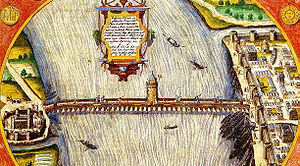Roman Bridge (Cologne)
Coordinates: 50 ° 56 ′ 16 ″ N , 6 ° 57 ′ 56 ″ E
| Roman Bridge (Constantine Bridge ) |
||
|---|---|---|
| Depiction of Stephan Brölmann from 1608, later colored by an unknown hand, but which does not correspond to the archaeological finds. View from the north. | ||
| Convicted | Connection Colonia Claudia - Divitia | |
| Crossing of | Rhine | |
| place | Cologne ( Germany ), Deutzer Bridge | |
| construction | Wooden bridge with stone pillars | |
| overall length | 420 m | |
| width | 10 m | |
| Number of openings | 20th | |
| completion | 310 AD | |
| Status | Destroyed | |
| location | ||
|
|
||
The Roman Bridge in Colonia Claudia Ara Agrippinensium ( Cologne ) was the first bridge over the Rhine in the area of today's Cologne and the wider area. The building was built under Emperor Constantine I by the Legio XXII Primigenia , which is why the name Konstantinbrücke or Konstantinische Brücke is common. In its place today the Deutz Bridge spans the Rhine.
Emergence
From a ceremonial speech given by Eumenius in Trier in honor of Constantine, it can be seen that construction work began in AD 310: “(The Franks) can so little think of crossing the river that they are now even though a bridge is being built , dare to do it even less. ”This year of origin could also be provisionally confirmed by the outermost annual ring of eight heavy oak stakes, which are exhibited in the Roman-Germanic Museum . In addition to oak, the Romans also used fir and beech wood to build bridges.
The bridge connected the Roman city on the left bank of the Rhine with the new bridgehead fort Divitia ( Castrum Divitia ) on the right bank in today's Deutz . It was the first solid bridge over the Rhine, "where the river is in the fullness of its strength, where it is terrible due to its powerful current."
construction
The bridge was built on 19 river pillars made of ashlar , between which wood binders were stretched. Fifteen of the river pillars could be proven by archaeological pile finds. It consisted of 42 boats with a laid lane, spanned the Rhine over a length of 420 m and was 10 m wide.
In the middle of the bridge it could be opened for shipping. This happened three times in the beginning, with increasing ship traffic more than 30 times a day. The archaeological finds can be seen in the Roman-Germanic Museum , as well as a reconstruction corresponding to the presumed appearance of the bridge.
purpose
The bridge connected the city on the left bank of the Rhine near today's Salzgasse with the bank on the right bank of the Rhine near today's Lanxess Tower , roughly equivalent to today's Deutz bridge . It spanned the Rhine with the Roman port of Castrum Divitia on the right bank of the Rhine , which was completed between 312 and 315 AD. The primary purpose of building the bridge and erecting the bridgehead was to be able to quickly bring troops across the Rhine to the area on the right bank of the Rhine, from which Franconia threatened Roman territory. To prevent the Franks from attacking, the Divitia bridgehead was built in enemy territory .
It is unclear whether and when it was demolished. While on the one hand it is assumed that it only stood there for about 100 years, on the other hand it is reported that it was only demolished in the 10th century (around 960). Because of the wooden construction, other sources assume that it could have decayed around AD 400.
literature
- Egon Schallmayer : Documents on the Roman Rhine Bridge in Cologne in the archive of the Saalburg Museum . Saalburg-Jahrbuch, Vol. 50. 2000 (2001), pp. 205–211.
Web links
- Page about Cologne bridges
- Another page about the Cologne Roman Bridge (PDF file; 4.4 MB)
Individual evidence
- ↑ Narrated in the Panegyrici Latini VII from the year 307 AD.
- ^ Hans Carl, Kunstchronik , Volume 21, 1968, p. 180.
- ^ A b Wolfgang Binsfeld, From the Roman Cologne: Historical Sketches , 1966, p. 23.


